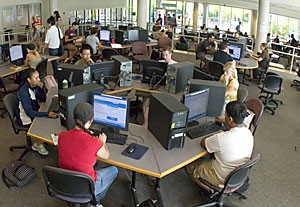The UA is trying to keep up with the times by expanding wireless Internet throughout campus.
Over the summer, 2.5 million square feet of wireless coverage was added, including in all residence halls and 12 other UA buildings, said Tom Magrini, network solutions assistant director of University Information Technology Services.
Technology Services is trying to cover all high-usage areas, he said.
More than 70 percent of the campus is now able to pick up the UA wireless signal, which covers seven million square feet of campus, said Bob Lancaster, network technology solutions director of Technology Services.
UAWiFi is made up of three networks, including a secure encrypted network that requires a NetID login, a non-encrypted public network and a guest network intended for sponsored visitors, Lancaster said.
He said his goal is to be aware of what technologies students are going to bring to campus and work to meet their needs.
“”It’s just an expectation,”” Lancaster said. “”We want to make sure that expectation is met.””
Magrini said that UAWiFi has more than 4,400 access points and has had more than 17,000 unique logins since the first day of school.
At peak periods, he added, more than 4,200 users have been online simultaneously.
A map showing the current indoor, outdoor and hotspot coverage on campus can be found at https://www.sirt.arizona.edu/wireless/cca/coverage.html.
Another new technological boost the UA offers is the Main Library’s streaming video reserves, which allows users to simultaneously access course media material 24 hours a day.
“”We are trying to help meet faculty needs when it comes to media items,”” said Robyn Huff-Eibl, library materials access team leader.
In the past, media requests from instructors were put in the physical reserves for students to check out, but only one student could access the materials at a time, Huff-Eibl said. The library can now take an item from its collection and digitize it for use on D2L or Blackboard, or stream it directly into the classroom.
The library remains very conscious of copyright laws and is trying to find a better way to meet everybody’s needs, Huff-Eibl said.
“”It should provide wider access to students,”” she said.
Huff-Eibl said that the project is just getting off the ground, with more than 300 videos digitized so far.
The Manuel T. Pacheco Integrated Learning Center has about 300 computers available for basic use, and its “”Multimedia Zone”” provides students with free access to more high-end computer programs, such as AutoCAD, Adobe products and video and animation software, said Limell Lawson, director of student computing resources.
“”You don’t need to be tech-savvy to benefit from these services,”” she said.
The ILC’s Information Commons, which houses multiple floors of computer stations, is usually overflowing during peak hours, but Lawson said there are no current plans for expansion.
“”We tell them to go to other labs, but a lot of times students say they’d rather wait,”” she said.
The student technology fee that began this semester is helping to pay for not only the expansion of UAWiFi but also for more video cameras for students to check out, as well as two 24-hour help desks to be installed next year, Lawson said.









